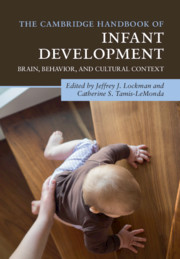Book contents
- The Cambridge Handbook of Infant Development
- The Cambridge Handbook of Infant Development
- Copyright page
- Dedication
- Contents
- Illustrations
- Contributors
- Preface
- Part I Foundations
- Part II Perceptual Development
- 6 Visual Development
- 7 Infant Visual Attention
- 8 Infants’ Perception of Auditory Patterns
- 9 The Development of Touch Perception and Body Representation
- 10 The Development of Infant Feeding
- 11 The Development of Multisensory Attention Skills
- Part III Cognitive Development
- Part IV Action
- Part V Language
- Part VI Emotional and Social Development
- Index
- References
10 - The Development of Infant Feeding
from Part II - Perceptual Development
Published online by Cambridge University Press: 26 September 2020
- The Cambridge Handbook of Infant Development
- The Cambridge Handbook of Infant Development
- Copyright page
- Dedication
- Contents
- Illustrations
- Contributors
- Preface
- Part I Foundations
- Part II Perceptual Development
- 6 Visual Development
- 7 Infant Visual Attention
- 8 Infants’ Perception of Auditory Patterns
- 9 The Development of Touch Perception and Body Representation
- 10 The Development of Infant Feeding
- 11 The Development of Multisensory Attention Skills
- Part III Cognitive Development
- Part IV Action
- Part V Language
- Part VI Emotional and Social Development
- Index
- References
Summary
In this chapter, we review the scientific evidence, primarily from experimental research, that reveals important aspects of the ontogeny of feeding and the development of food preferences and food choice in the context of the mother. We focus on the first 2 years of life, when children make the drastic transition from eating an all-liquid diet to one containing solid foods. We focus on feeding in the context of the mother, exploring the contribution of each member of the dyad: the infant (who is being fed) and the mother (who is selecting the foods and feeding the child).
Information
- Type
- Chapter
- Information
- The Cambridge Handbook of Infant DevelopmentBrain, Behavior, and Cultural Context, pp. 263 - 302Publisher: Cambridge University PressPrint publication year: 2020
References
Accessibility standard: Unknown
Why this information is here
This section outlines the accessibility features of this content - including support for screen readers, full keyboard navigation and high-contrast display options. This may not be relevant for you.Accessibility Information
- 3
- Cited by
